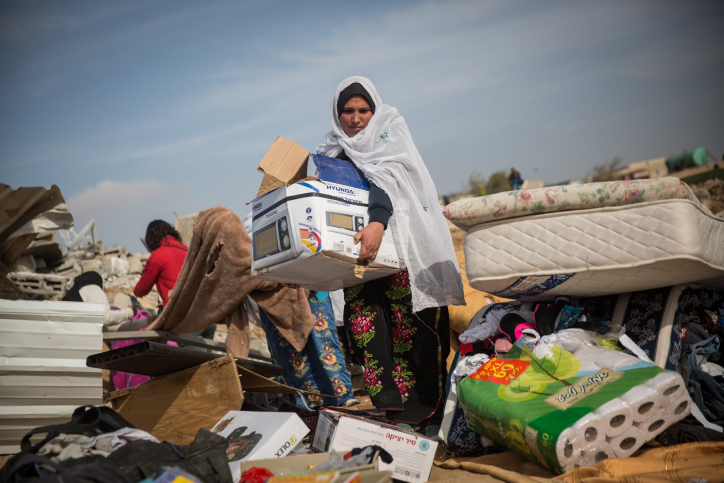Protests against Arab families moving into Jewish cities are a reminder that until everyone is free to choose where they want to live, the Israeli regime will remain segregationist and racist at its core.
By Suhad Bishara

Jewish residents of the northern Israeli city of Afula protested last week against the sale of a home to an Arab family and the possibility that the city would have a mixed Jewish-Arab population. I have no doubt that every person who believes in freedom and justice will view this protest as an expression of pro-segregation racism reminiscent of South African apartheid.
The protest comes just a few months after Sivan Yehieli, the head of the Kfar Vradim Municipal Council, announced that his pastoral town must maintain its Zionist-Jewish character after 58 Arab citizens won bids to build their homes in the town.
Let’s make one thing clear: 150 protesters are not an aberration in Israel. They were simply expressing overtly the racist segregation upon which Israel’s land regime was founded. This is precisely how military rule over Israel’s Arab citizens – in effect from 1949 until 1966 – functioned: “cleansing” vast swaths of land in order to settle Jews and to ensure reserves of land that would continue to exclusively serve Israeli Jews.
This “cleansing” process was implemented, among other ways, via the construction of hundreds of new Jewish towns and communities, as well as through the establishment of admissions committees in kibbutzim, moshavim, and other communities.
Yehieli faithfully represents the Israeli planning authorities’ policy aimed at demographically re-engineering the country. He represents an Israeli legal system that refused to allow the implementation of its own decision to allow the internally-displaced Palestinian residents of Iqrit and Bir’im to return to their villages, that gave the green light to the Admissions Committees Law, and that allows the state to uproot the residents of Umm al-Hiran in order to replace them with Jewish citizens – just like during and immediately following the Nakba. And we can expect much more of the same.

It is no coincidence that the proposed nation-state basic law includes a clause that authorizes the state to “allow a community, including those belonging to one religion or nationality, to maintain separate community living.” This proposed basic law will constitutionally and normatively affirm Israel’s policy of segregation. In effect, Arabs’ citizenship will continue to be contingent, provided that it does not conflict with Jewish statehood and supremacy and the “right” of Jewish citizens to choose to live separately without other citizens sabotaging their desire for homogeneity.
Much of the criticism leveled at the racism of Afula’s residents focuses on the lack of development in Arab communities, which results in the necessity of young Arab citizens to seek housing solutions in nearby Jewish towns.
This thinking prevents envisioning a situation in which an Arab citizen of Israel has the right to choose where she/he wants to live simply because it suits her/him to live there. It buys into the paradigm of a discriminatory, racist, and apartheid-like land regime that forces them to find a circumstantial explanation for the phenomenon, rather than simply calling it by its name: racism and segregation.
Imagine a scenario in which the Israeli government takes unprecedented steps to allocate land for the development of Arab communities. Imagine that it begins developing Arab communities of all kinds — cities, villages, and agricultural communities — while also ensuring the development of industrial and commercial zones in accordance with the principles of distributive and restorative justice.
But yet, even in this scenario, it remains the right of every Arab citizen to decide where he or she wants to live — be it Kfar Vradim, Tel Aviv, or Afula.
As long as Israeli state authorities cannot or will not imagine the country’s land as open to all, we cannot talk about justice or constitutional rights. The Israeli regime will remain segregationist and racist at its core. Segregated living will remain racist, even under the guise of “separate but equal.”
Imagine protesters demonstrating against Jews buying homes in a Christian town in Europe. Israelis would declare them racists and anti-Semites, and Israel’s prime minister would surely remark that it reminds him of the dark days leading up to the Holocaust. Inside Israel, however, an almost identical scene is framed by Afula’s former mayor Avi Elkabetz as such: “The residents of Afula do not want a mixed city. They want a Jewish city — and this is their right. This isn’t racism.”
Thus racism in Israel magically becomes the “legitimate right” of the Jewish citizen.
Attorney Suhad Bishara is the Director of the Land and Planning Rights Unit, Adalah – The Legal Center for Arab Minority Rights in Israel. This article was first published in Hebrew on Haokets. Read it here.

